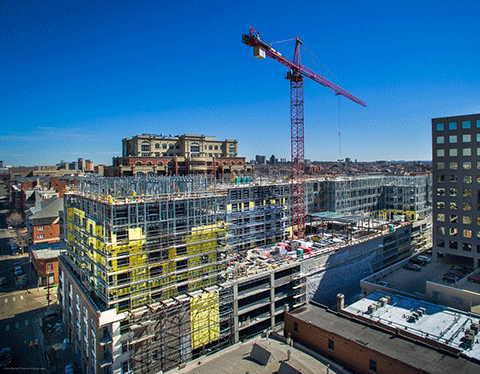More and more people are experiencing extreme commutes because affordable housing can’t be found within a 20-mile radius of urban centers. Developers are pushing out to the suburbs to find cheaper land and to be able to provide the type of housing and amenities residents want.
But what if a new building system enabled developers to get 40% more units on a site?
“On Alexan Uptown, Trammell Crow Residential [TCR] was able to yield significantly more units than with a typical wood-frame design approach,” says Brendan McDonough, associate director of business development at Prescient, discussing a project his firm worked on with TCR in Denver. The Durham, N.C.–based firm’s structural system employs building information modeling in the design and manufacturing of its building components.
Since the Alexan Uptown collaboration, TCR has hired Prescient on four more projects, including Alexan Cherry Creek, also in Denver. The team credits the contracting of Prescient to the company’s fully integrated and proprietary design, manufacturing, and installation process. TCR was able to get more density using a Prescient-built building, which enabled the developer to make more aggressive offers for the land while fitting in twice as many units as originally planned, McDonough says.
Prescient’s steel system pushed the height of Alexan Uptown to 12 stories rather than the five or fewer stories usually associated with wood-frame construction.
Calculated Risk
TCR is using the automated process for more than just its development benefits: The firm appreciates the additional value the building system creates by enabling all a project’s stakeholders to operate more effectively too, says JJ Williams, regional vice president at Prescient.
Not that there haven’t been challenges and risks involved for both parties.
“TCR is one of the top developers in the country, and very conservative,” Williams says. “They’re very risk averse. They want the best ROI out of their investment. Our first learning curve was having to get this large, conservative developer to take a risk on a new, innovative product. They did a great deal of research [into Prescient’s] financial capabilities and stability before they got comfortable.”
Trammell Crow had to get comfortable with Prescient’s operations, as well. Most developers have legacy practices in place and it’s risky not to use them.
“The AEC [architecture, engineering, and construction] industry is the second producer to the national GDP, but the least productive,” says Williams. “Prescient’s is a disruptive technology, and we’re disrupting the way the industry has performed for hundreds of years. Top developers, willing to take a risk, are quickly learning that we’ve revolutionized the process. And they also want to reduce costs and compress schedules.”
By taking the risk, developers can reduce the entire life cycle of their projects as much as six months to a year, claims Williams. The system is able to fill a niche in the market that used to be absent of alternative building methods to wood and concrete. McDonough says Prescient’s system can build up to 16 stories and shave 20% to 30% off the construction schedule and 20% to 30% off costs, as well.
The Prescient system is designed and engineered in a complete digital model, then manufactured and erected in the field with an unprecedented accuracy, not achieved before in the industry. This offers other sub-trades the ability to reduce time and cost further adding value to the developer.
“We reduce 60% to 70% of on-site clash detection that is typically involved with conventional building methods,” Williams says.
What can’t this design and construction system do? Currently, it’s limited by code to go beyond 180 feet. The structure could handle more, but code won’t allow it until further testing has been completed, Williams says.
Prescient is collaborating on the 2017 Multifamily Executive Concept Community, which will be presented at the Multifamily Executive Conference, Sept. 18–20, in Las Vegas. Register now to attend, at www.mfeconference.com.

